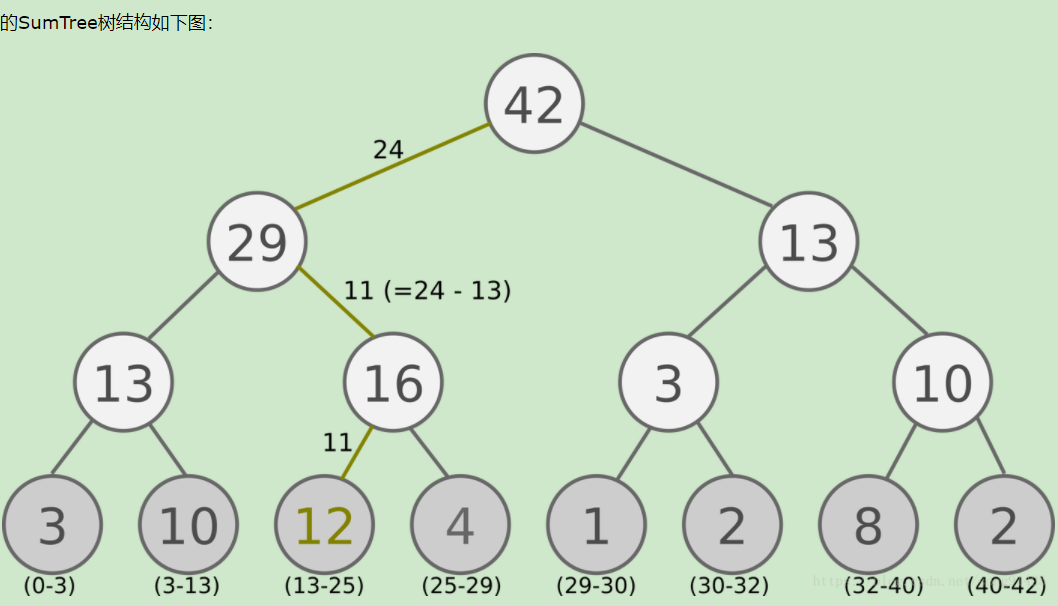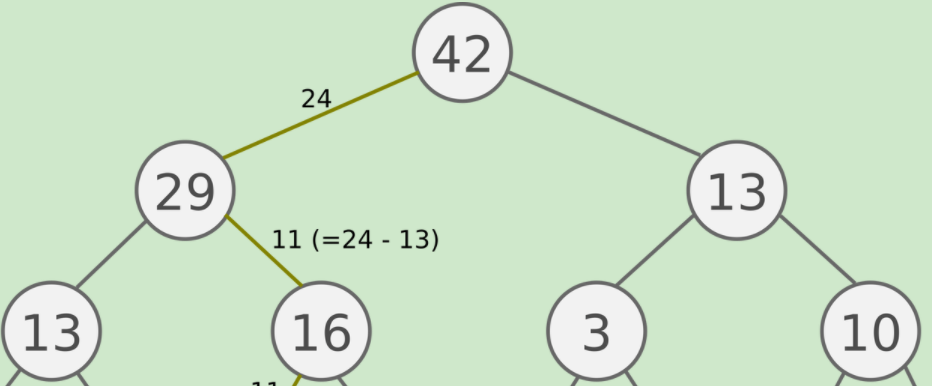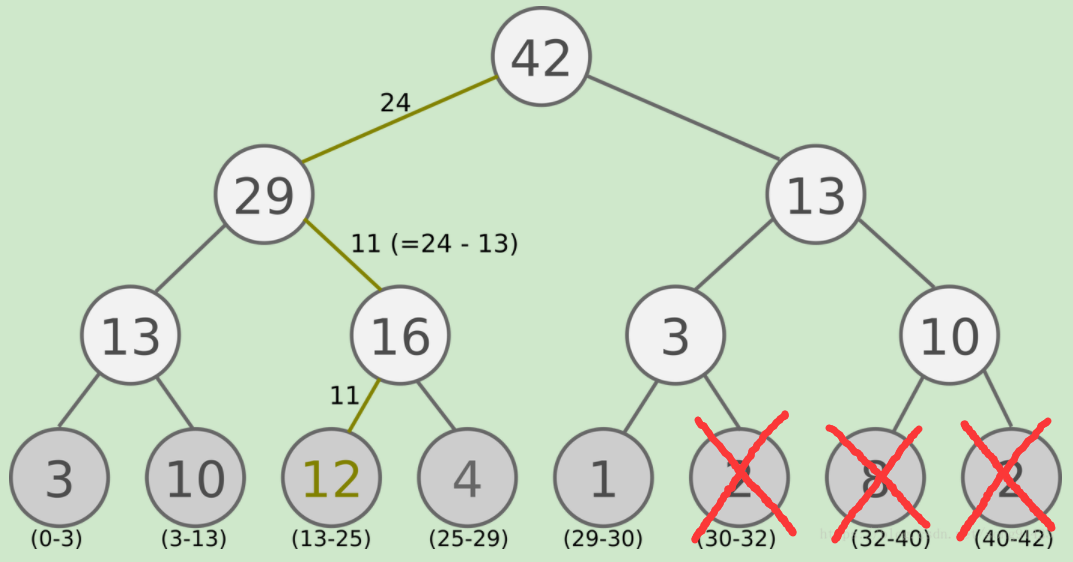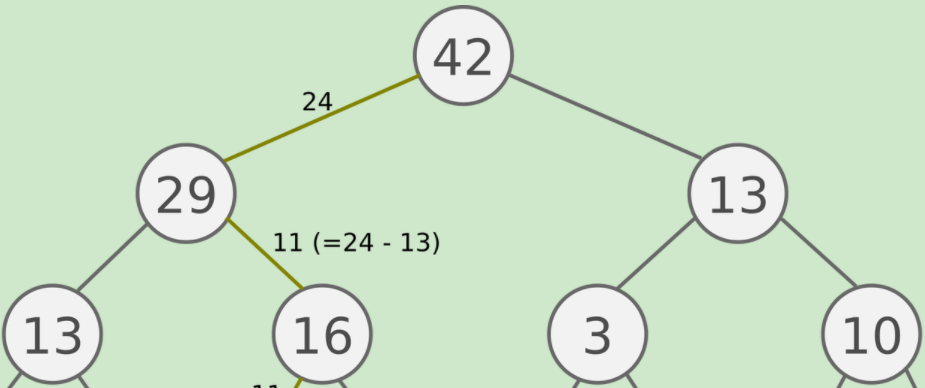分段树(segment tree)的实现 —— 强化学习中 "优先级回放机制" 的重要组成部分
分段树(segment tree)是强化学习中 "优先级回放机制" 的重要组成部分。本文针对分段树(segment tree)的一个开源版本的实现来进行分析,代码地址:
https://gitee.com/devilmaycry812839668/Rainbow/blob/master/memory.py
Transition_dtype = np.dtype(
[('timestep', np.int32), ('state', np.uint8, (84, 84)), ('action', np.int32), ('reward', np.float32),
('nonterminal', np.bool_)])
blank_trans = (0, np.zeros((84, 84), dtype=np.uint8), 0, 0.0, False) # Segment tree data structure where parent node values are sum/max of children node values
class SegmentTree():
def __init__(self, size):
self.index = 0
self.size = size
self.full = False # Used to track actual capacity
self.tree_start = 2 ** (size - 1).bit_length() - 1 # Put all used node leaves on last tree level
self.sum_tree = np.zeros((self.tree_start + self.size,), dtype=np.float32)
self.data = np.array([blank_trans] * size, dtype=Transition_dtype) # Build structured array
self.max = 1 # Initial max value to return (1 = 1^ω) # Updates nodes values from current tree
def _update_nodes(self, indices):
children_indices = indices * 2 + np.expand_dims([1, 2], axis=1)
self.sum_tree[indices] = np.sum(self.sum_tree[children_indices], axis=0) # Propagates changes up tree given tree indices
def _propagate(self, indices):
parents = (indices - 1) // 2
unique_parents = np.unique(parents)
self._update_nodes(unique_parents)
if parents[0] != 0:
self._propagate(parents) # Updates values given tree indices
def update(self, indices, values):
self.sum_tree[indices] = values # Set new values
self._propagate(indices) # Propagate values
current_max_value = np.max(values)
self.max = max(current_max_value, self.max) # Propagates single value up tree given a tree index for efficiency
def _propagate_index(self, index):
parent = (index - 1) // 2
left, right = 2 * parent + 1, 2 * parent + 2
self.sum_tree[parent] = self.sum_tree[left] + self.sum_tree[right]
if parent != 0:
self._propagate_index(parent) # Updates single value given a tree index for efficiency
def _update_index(self, index, value):
self.sum_tree[index] = value # Set new value
self._propagate_index(index) # Propagate value
self.max = max(value, self.max) def append(self, data, value):
self.data[self.index] = data # Store data in underlying data structure
self._update_index(self.index + self.tree_start, value) # Update tree
self.index = (self.index + 1) % self.size # Update index
self.full = self.full or self.index == 0 # Save when capacity reached
self.max = max(value, self.max) # Searches for the location of values in sum tree
def _retrieve(self, indices, values):
children_indices = (indices * 2 + np.expand_dims([1, 2], axis=1)) # Make matrix of children indices
# If indices correspond to leaf nodes, return them
if children_indices[0, 0] >= self.sum_tree.shape[0]:
return indices
# If children indices correspond to leaf nodes, bound rare outliers in case total slightly overshoots
elif children_indices[0, 0] >= self.tree_start:
children_indices = np.minimum(children_indices, self.sum_tree.shape[0] - 1)
left_children_values = self.sum_tree[children_indices[0]]
successor_choices = np.greater(values, left_children_values).astype(
np.int32) # Classify which values are in left or right branches
successor_indices = children_indices[
successor_choices, np.arange(indices.size)] # Use classification to index into the indices matrix
successor_values = values - successor_choices * left_children_values # Subtract the left branch values when searching in the right branch
return self._retrieve(successor_indices, successor_values) # Searches for values in sum tree and returns values, data indices and tree indices
def find(self, values):
indices = self._retrieve(np.zeros(values.shape, dtype=np.int32), values)
data_index = indices - self.tree_start
return (self.sum_tree[indices], data_index, indices) # Return values, data indices, tree indices # Returns data given a data index
def get(self, data_index):
return self.data[data_index % self.size] def total(self):
return self.sum_tree[0]
分段树的具体逻辑结构如下:(原图地址:https://www.cnblogs.com/pinard/p/9797695.html)

这个segment tree可以分为两个部分,一个部分是权重(待检索数据的权重)的索引部分,另一部分是数据(待检索数据)的存储部分。
上图中的数据部分(待检索的数据)就是下图的表示:

权重(待检索数据的权重)的索引部分为:

===================================================
代码分析:
在__init__ 函数部分:

self.size = size #指的是需要存储的数据(待检索的数据)的最多个数。
self.full #是记录存储的数据个数有没有达到最多个数的要求,即是否存储满。
self.tree_start = 2 ** (size - 1).bit_length() - 1
#比较不好理解的部分,如果存储size个数据,那么需要编号的话就是0 到 size-1 ,
#最大的编号size-1的二进制表示的长度为 (size - 1).bit_length(),
# (size - 1).bit_length() 长的二进制位所能表示的最多个数编号为 0 到 2 ** (size - 1).bit_length() - 1
形象的说,看下图:

如果我们有5个数据,而这5个数据全部为同一层的叶子节点,那么构建一个二叉树后如果非叶子节点的部分为满二叉树,那么非叶子节点的部分为 7。


非叶子节点,也是分段树中索引节点的个数,在size=5时,个数为7 。
self.sum_tree = np.zeros((self.tree_start + self.size,), dtype=np.float32)
生成一个float数组矩阵,大小为索引节点个数 self.tree_start 与 数据节点个数 self.size 的和。其中,索引节点和数据节点存储的都是权重值。
segment tree中存储的是待检索数据的权重,其中叶节点是直接存储的待检索数据的权重,非叶节点则存储的是子节点权重之和。而self.data 则是存储的待检索数据,数据的数据类型为自定义的 Transition_dtype
self.data = np.array([blank_trans] * size, dtype=Transition_dtype)
self.max = 1 #初始化segment tree时新存入节点的默认权重值,初始化为 1
=====================================================
单个数据的插入,并更新segment tree中对应的权重值,并对与其相关的上层节点的权重值进行更新。
# Propagates single value up tree given a tree index for efficiency
def _propagate_index(self, index):
parent = (index - 1) // 2
left, right = 2 * parent + 1, 2 * parent + 2
self.sum_tree[parent] = self.sum_tree[left] + self.sum_tree[right]
if parent != 0:
self._propagate_index(parent) # Updates single value given a tree index for efficiency
def _update_index(self, index, value):
self.sum_tree[index] = value # Set new value
self._propagate_index(index) # Propagate value
self.max = max(value, self.max) def append(self, data, value):
self.data[self.index] = data # Store data in underlying data structure
self._update_index(self.index + self.tree_start, value) # Update tree
self.index = (self.index + 1) % self.size # Update index
self.full = self.full or self.index == 0 # Save when capacity reached
self.max = max(value, self.max)
由于我们的数据是存储在 self.data 中, 而数据对应的权重值是存储在segment tree中。
self.index 是 self.data 中当前可以写入的位置的索引号。同时,self.index+self.tree_start 也是对应权重在 self.sum_tree 中的索引位置。
def append: 中的输入参数value则是数据data对应的权重值。也就是说self.sum_tree中索引号self.index+self.tree_start中所存储的权重值为value。
def _propagate_index(self, index) 函数:
更新segment tree中子节点的父节点权重值,segment tree中索引为index的节点的父节点的索引为 parent = (index - 1) // 2
而index节点的父节点的子节点中的左右节点分别为: left, right = 2 * parent + 1, 2 * parent + 2
当然,index节点的左右子节点中也必然包括index节点。
self.sum_tree[parent] = self.sum_tree[left] + self.sum_tree[right]
根据左右子节点的权重更新父节点的权重值。
if parent != 0:
self._propagate_index(parent)
迭代修改父节点的权重值,直到修改到根节点,即索引号为0的节点。
def _update_nodes(self, indices):
def _update_nodes(self, indices):
def update(self, indices, values):
一次性为多个节点修改权重值,具体类似于插入单个节点。
===========================================================
检索操作,在segment_tree中检索多个值(values)的索引号,并将其存入 indices 中。
检索操作应该是segment_tree的精髓部分,segment_tree 最重要的一个功能就是按照self.data中元素所对应的self.sum_tree中的权重值进行随机采样。
indices = self._retrieve(np.zeros(values.shape, dtype=np.int32), values)
def _retrieve(self, indices, values):
children_indices = (indices * 2 + np.expand_dims([1, 2], axis=1)) # Make matrix of children indices
# If indices correspond to leaf nodes, return them
if children_indices[0, 0] >= self.sum_tree.shape[0]:
return indices
# If children indices correspond to leaf nodes, bound rare outliers in case total slightly overshoots
elif children_indices[0, 0] >= self.tree_start:
children_indices = np.minimum(children_indices, self.sum_tree.shape[0] - 1)
left_children_values = self.sum_tree[children_indices[0]]
successor_choices = np.greater(values, left_children_values).astype(
np.int32) # Classify which values are in left or right branches
successor_indices = children_indices[
successor_choices, np.arange(indices.size)] # Use classification to index into the indices matrix
successor_values = values - successor_choices * left_children_values # Subtract the left branch values when searching in the right branch
return self._retrieve(successor_indices, successor_values)
children_indices = (indices * 2 + np.expand_dims([1, 2], axis=1))
indices ,多个值的索引,children_indices 为indices所对应的父节点下的左右子节点的索引矩阵,0行(matrix的0行)为所有左子节点的索引值,1行(matrix的1行)为所有右子节点的索引值。这里初始化时多个值的初始索引均设置为根节点,即0号节点。
children_indices[0, 0] >= self.sum_tree.shape[0] 子节点索引号最小的,即children_indices[0, 0] (因为indices中索引值为从小到大顺序排列),如果最小索引值大于self.sum_tree的长度则表示当前节点(即indices节点)为叶子节点。

该部分代码对应的情形如下:

children_indices[0, 0] >= self.tree_start 如果索引号最小的节点小于segment tree的非叶子节点个数,那么子节点children_indices必然是叶子节点。
但是在该种情况下,会出现indices子节点不为叶子节点,该种情况下会有部分子节点不属于segment tree,如上图中的红叉部分节点(这里特指第一个红叉的点)。
第一个红叉的点需要被排除掉,因为第一个红叉点的索引号已经超出了segment tree中所能表示的叶节点的范围。其实,该种情况极难发生,因为不对次情况做处理的话也是会在下一步中只考虑对应的左子节点,因为待检索的权重值必然小于左子节点所对应的权重值,因此不对后续结果有影响。但是由于极小概率下浮点数表示的精度问题会导致将第一个红叉点也加入到考虑范围内,因此对该种情况进行特殊处理。

如果查找的权重值value大于左子节点的权重值则下一个查找的节点为右子节点。如果下次迭代从右子节点开始查找对应的权重值,则需要将待查找的权重value减去左子节点的权重。
self._retrieve(successor_indices, successor_values)
反复迭代查找权重值,直到达到叶子节点。
参考文献:
https://www.cnblogs.com/pinard/p/9797695.html
分段树(segment tree)的实现 —— 强化学习中 "优先级回放机制" 的重要组成部分的更多相关文章
- 『线段树 Segment Tree』
更新了基础部分 更新了\(lazytag\)标记的讲解 线段树 Segment Tree 今天来讲一下经典的线段树. 线段树是一种二叉搜索树,与区间树相似,它将一个区间划分成一些单元区间,每个单元区间 ...
- 线段树(Segment Tree)(转)
原文链接:线段树(Segment Tree) 1.概述 线段树,也叫区间树,是一个完全二叉树,它在各个节点保存一条线段(即“子数组”),因而常用于解决数列维护问题,基本能保证每个操作的复杂度为O(lg ...
- 强化学习中的无模型 基于值函数的 Q-Learning 和 Sarsa 学习
强化学习基础: 注: 在强化学习中 奖励函数和状态转移函数都是未知的,之所以有已知模型的强化学习解法是指使用采样估计的方式估计出奖励函数和状态转移函数,然后将强化学习问题转换为可以使用动态规划求解的 ...
- 深度强化学习中稀疏奖励问题Sparse Reward
Sparse Reward 推荐资料 <深度强化学习中稀疏奖励问题研究综述>1 李宏毅深度强化学习Sparse Reward4 强化学习算法在被引入深度神经网络后,对大量样本的需求更加 ...
- 强化学习中REIINFORCE算法和AC算法在算法理论和实际代码设计中的区别
背景就不介绍了,REINFORCE算法和AC算法是强化学习中基于策略这类的基础算法,这两个算法的算法描述(伪代码)参见Sutton的reinforcement introduction(2nd). A ...
- BZOJ.4695.最假女选手(线段树 Segment tree Beats!)
题目链接 区间取\(\max,\ \min\)并维护区间和是普通线段树无法处理的. 对于操作二,维护区间最小值\(mn\).最小值个数\(t\).严格次小值\(se\). 当\(mn\geq x\)时 ...
- SpiningUP 强化学习 中文文档
2020 OpenAI 全面拥抱PyTorch, 全新版强化学习教程已发布. 全网第一个中文译本新鲜出炉:http://studyai.com/course/detail/ba8e572a 个人认为 ...
- 强化学习中的经验回放(The Experience Replay in Reinforcement Learning)
一.Play it again: reactivation of waking experience and memory(Trends in Neurosciences 2010) SWR发放模式不 ...
- 【数据结构系列】线段树(Segment Tree)
一.线段树的定义 线段树,又名区间树,是一种二叉搜索树. 那么问题来了,啥是二叉搜索树呢? 对于一棵二叉树,若满足: ①它的左子树不空,则左子树上所有结点的值均小于它的根结点的值 ②若它的右子树不空, ...
- 线段树(segment tree)
线段树在一些acm题目中经常见到,这种数据结构主要应用在计算几何和地理信息系统中.下图就为一个线段树: (PS:可能你见过线段树的不同表示方式,但是都大同小异,根据自己的需要来建就行.) 1.线段树基 ...
随机推荐
- jsp表单提交中的逻辑判断
针对于表单 通常情况下 我们都是表单提交 提交的路径为以下: 提交的按钮的type="submit" 当我们想在表单提交前增加一个逻辑判断 我们就需要把button中的typ ...
- 短链服务接口慢优化 redis应用
短链服务接口慢优化 redis应用 短链接服务:1.长链接 查询 短链接(长链接如果存在,直接返回短链接,如果长链接不存在,则需要生成短链接),比如:在获取短信之前,或者管理后台编辑短信内容之前,需要 ...
- FEL - Fast Expression Language
开源好用的表达式计算语言FEL,可惜了官网文档不在国内,我来copy个过来. Fel是轻量级的高效的表达式计算引擎 Fel在源自于企业项目,设计目标是为了满足不断变化的功能需求和性能需求. Fel是开 ...
- python 判断token是否有效,若失效,重新发起token请求
场景: 1.对一个接口,进行接口自动化测试,查找的是有权限操作的用例,传入到获取token接口,生成token,判断当前是否有token,如果存在token,则无需再次发起token接口: 存在的问题 ...
- JSONPATH-阿里和jayway的实现测试
业务业务的需要,所以想找一个从对象中获取属性的工具. 搜了搜发现由阿里和jayway的实现,又花费了一些时间了解和练习,总结了一些要点: 阿里的可能快一些,但考虑到完备性,也许选择jayway更好一些 ...
- Prometheus监控系统(一)Prometheus介绍
1. Prometheus简介 Prometheus受启发于Google的Brogmon监控系统(类似kubernetes是从Google的Brog系统演变而来).于2012年以开源形式发布,在201 ...
- 『vulnhub系列』EVILBOX-ONE
『vulnhub系列』EVILBOX-ONE 下载地址: https://www.vulnhub.com/entry/evilbox-one,736/ 信息搜集: 使用nmap探测内网存活主机,发现开 ...
- 哇塞,实测780MB/s!基于RK3568J与FPGA的PCIe通信案例详解
ARM + FPGA架构有何种优势 近年来,随着中国新基建.中国制造2025的持续推进,单ARM处理器越来越难满足工业现场的功能要求,特别是能源电力.工业控制.智慧医疗等行业通常需要ARM + FPG ...
- 实时系统Preempt RT与Xenomai之争!谁更主流,谁更实时?
选择争论一直存在 大家知道EtherCAT是实时现场总线技术,当我们开发一款支持EtherCAT总线的控制器时,实时操作系统的选择不仅对于产品本身是最重要的一部分,而且对产品研发的整个过程也影响深远. ...
- 2024年,AI驱动测试管理工具会有哪些发展前景呢?
随着人工智能技术的日新月异,2024年的测试管理工具将迎来全新的发展机遇.AI赋能将助力测试管理工具实现前所未有的智能化升级,为软件研发团队带来革命性的变革. 一.什么是AI? 人工智能(AI)是一种 ...
